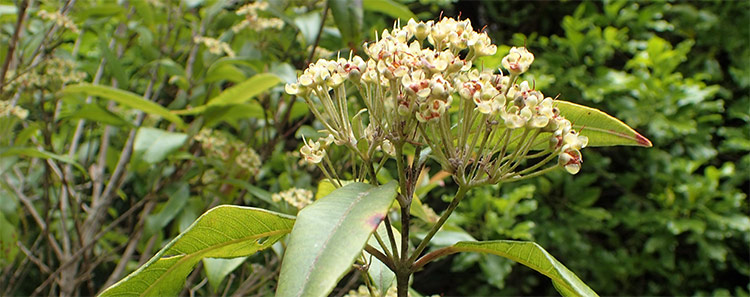Lemon Myrtle Essential Oil
Backhousia citriodora

Photo Credit: Backhousia citriodora kz02.jpg by Krzysztof Ziarnek, Kenraiz. Cropped image. Licensed under CC BY-SA 4.0
Description
Lemon Myrtle Essential Oil is an absolute aromatic delight to lemon lovers. Containing upwards of 96% of the aldehyde citral (geranial and neral), it possesses a clear, strong lemon aroma that far surpasses Lemon Essential Oil in lemony intensity.

Lemon Myrtle Essential Oil is a strongly potent anti-bacterial essential oil. It is wonderful to include in inhaler and diffusion blends. It can be helpful for use with acne and oily skin, but it must be used very carefully and at very low dilutions. Tisserand and Young recommend a dermal maximum of 0.7% (see the Essential Oil Safety section below for more information).
Aromatically, Lemon Myrtle Essential Oil blends well with essential oils in the citrus, wood, floral, camphorous, and mint families.
Emotionally, Lemon Myrtle Essential Oil is a wonderfully uplifting oil. When used in low dilutions, it can simultaneously help to calm fragile nerves and help with anxiety.
Lemon Myrtle Essential Oil Properties, Benefits and Uses
- Influenza
- Bronchitis
- Herpes Simplex
- Antibacterial
- Antifungal
- Sedative
- Carminative
Source: Salvatore Battaglia, The Complete Guide to Aromatherapy (Australia: The Perfect Potion, 2003), 292.
Botanical Name
Plant Family
Common Method of Extraction
Steam Distilled
Plant Part Typically Used
Color
Clear to Pale Yellow
Consistency
Thin
Perfumery Note
Top
Strength of Initial Aroma
Strong
Aromatic Description
Lemon Myrtle Essential Oil smells fresh, sweet and has an intense lemony aroma.
Major Constituents
- Geranial
- Neral
- Isogeranial
- Isoneral
- 6-Methyl-5-hepten-2-one
- Linalool
Source: I.A. Southwell, M. Russell, R.L. Smith, et. al. Backhousia citriodora F. Muell. (Myrtaceae), a Superior Source of Citral. (Journal of Essential Oil Research 12, 2000), 735-741. Source cited in Robert Tisserand and Rodney Young, Essential Oil Safety (Second Edition. United Kingdom: Churchill Livingstone Elsevier, 2014), 360.
Lemon Myrtle Essential Oil Safety Information
Tisserand and Young caution that a drug interaction may occur if using drugs metabolized by CYP2B6 and that there is a risk of teratogenicity. They precaution against topical use in children and infants under age 2 and for those with hypersensitive/diseased/damaged skin. They recommend a dermal maximum of 0.7%. Reading Tisserand and Young's full profile is recommended. [Robert Tisserand and Rodney Young, Essential Oil Safety (Second Edition. United Kingdom: Churchill Livingstone Elsevier, 2014), 360-361.]
General Safety Information
Do not take any oils internally and do not apply undiluted essential oils, absolutes, CO2s or other concentrated essences onto the skin without advanced essential oil knowledge or consultation from a qualified aromatherapy practitioner. For general dilution information, read AromaWeb's Guide to Diluting Essential Oils. If you are pregnant, epileptic, have liver damage, have cancer, or have any other medical problem, use oils only under the proper guidance of a qualified aromatherapy practitioner. Use extreme caution when using oils with children and be sure to first read the recommended dilution ratios for children. Consult a qualified aromatherapy practitioner before using oils with children, the elderly, if you have medical issues or are taking medications. Before using this or any essential oil, carefully read AromaWeb's Essential Oil Safety Information page. For in-depth information on oil safety issues, read Essential Oil Safety by Robert Tisserand and Rodney Young.
Shelf Life
Important Information About the Profiles
The essential oil information provided on AromaWeb is intended for basic educational purposes only. The references to safety information, test results, constituents and percentages is generalized information. Essential oils can vary greatly in composition. The data is not necessary complete and is not guaranteed to be accurate. The essential oil photos are intended to represent the typical and approximate color of each essential oil. However, essential oil composition and color can vary based on harvesting, distillation, age of the essential oil and other factors. Profiles for several CO2 Extracts and absolutes are included within the directory, and are denoted as such.
